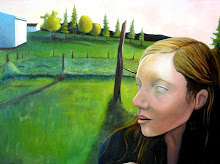

The first class came in and Ryan and I gave them a talk about the way to make quill pens and ink, and I also talked about literacy. The kids seemed more interested in dipping their quills into the Dixie cups of ink we had set out on the table. We suggested that the students write letters, but told then they could do whatever they wanted. I was surprised at how enthusiastic most of the kids became. Some of them completed three letters in the span of a half hour. Others drew pictures of cows, rabbits, cats, and dogs. One boy did a very nice abstract piece, and when I told him, “That looks very modern,” he said, “I know.”

 Next the kids were told to bring their letters to me so I could blot them. This is the process by which you remove the excess ink from the paper, and it basically just entails pressing down with a paper towel. (We made blotter books that were paper towels and cardboard.) I folded the letters for them and then they took them to Ryan whose job it was to melt ceiling wax over a burning candle and let drops fall onto the letter so that they would be sealed. We also had stampers there to press into the wax and make a design.
Next the kids were told to bring their letters to me so I could blot them. This is the process by which you remove the excess ink from the paper, and it basically just entails pressing down with a paper towel. (We made blotter books that were paper towels and cardboard.) I folded the letters for them and then they took them to Ryan whose job it was to melt ceiling wax over a burning candle and let drops fall onto the letter so that they would be sealed. We also had stampers there to press into the wax and make a design.

With the second class we had basically the same results. I noticed that with this class the teacher and chaperones were much less involved with the project and helping the kids, but they all were still enthusiastic and made multiple projects. At the end of it all I thought that this project in particular was a good one to help convey history to kids because it forces them to do something that they do everyday (write) as a person living during the eighteenth century would have done it. I think they can connect with that a little bit better than with other activities like candle making for example, that they would probably never do in their normal lives. Still I think that activities like this just exaggerate the weird aspects of history. They encourage people to think of the past in sensationalist terms, to marvel at the backwardness of past societies, and stress the discontinuity between the past and the present. I am very interested in this aspect of how the public views the past and I hope to explore it more as my internship goes on. I think it is part of the reason why Amish is a household word and people like to go to reenactments so much.


No comments:
Post a Comment